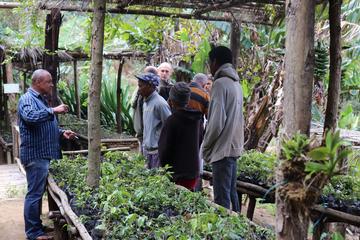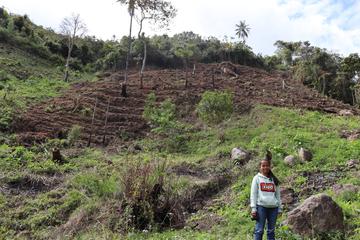A series of guides to make the Tsiperifery sector more sustainable
At the heart of a Tsiperifery forest
7:30. We leave the hustle and bustle of the capital to reach the colorful hills and rice fields as we drive on the RN2 towards the Mandraka forest, 65km east of Antananarivo. We meet Olivier Ramaherison in his home in the Mandraka, bordering a secondary forest of Tsiperifery, which hosts its tree nurseries of wild pepper.
Of French-Malagasy origin, Olivier returned to settle in Madagascar 10 years ago when he inherited a plot of forest from his grandfather. In April 2013, he started the construction of the nurseries and then planted the cuttings in the forest in October 2014. But the beginnings were difficult and his first trials of cuttings were not encouraging. "I followed the technical itinirery of the Piper nigrum (with aerial branches) but the cuttings did not take despite germination tests and growth hormones. Then suddenly the cuttings started to take. So I discussed with Jean Lichou, a former CIRAD engineer, who hypothesized that this growth would be linked to the presence of mycorrhizae [1] in the natural humus of Tsiperifery and that the mycorrhizae would favor the rate of recovery during cuttings. So I used it as a substrate for cuttings "explains Olivier.
In addition, Olivier has developed cuttings from creeping twigs, which differs from the usual technical route for black pepper that plans to take aerial branches. For the Tsiperifery, it seems that the recovery rate is much better (80%) with the creeping twigs while the aerial branches (at low recovery rate 15%) fructify them much faster.
"In recent years, we have done several domestication tests of wild pepper and we would like to confirm some hypotheses through research. It is with this in mind that I put at the disposal of Fameno a plot of forest so that she can carry out her thesis experiments".
PhD student at the University of Antananarivo, Fameno Ramahavalisoa is doing a thesis on the genotype-environment interaction of Tsiperifery pepper as part of the Dometsip project. Her thesis is divided into two parts : (1) The study of the impact of the cuttings in cascade on the growth of the cuttings ; (2) The architecture and development of the plant from the seed until maturity.
With a large field, Olivier decided to diversify his activities by producing essential oil of pepper, ginger and geranium.
This field day allowed us to discover the significant progress made by Olivier and his team on the Mandraka site, namely 150 000 feet of Tsiperifery replanted in the forest the past 5 years and 30 000 cuttings in nursery each year.
Developing practical guides for the sector
The second part of the mission was devoted to the development of guides of good practices for sustainable cultivation and processing of Tsiperifery. A two-day workshop brought together about fifteen actors from the Tsiperifery sector of Madagascar (researchers, gatherers, technicians ...) around the drafting of these guides.
The Guides of Good Practices for the culture and processing of wild pepper (in Malagasy and in French) should be available in October 2018. A mission of presentation / test of these guides on a pilot site (close to the National Park of Ranomafana) will take place at the beginning of October 2018.
This mission was carried out as part of the Dometsip, Capetsip and Interreg-V Qualinnov 2 projects, funded by the European Union, the Region Reunion and the French Embassy to Madagascar.
[1] Symbiotic association between molds and roots of wild pepper


